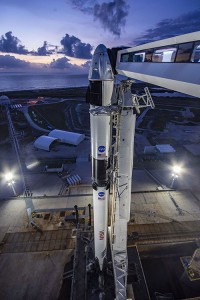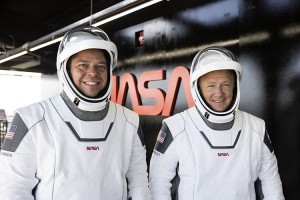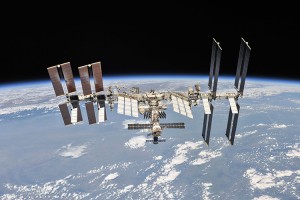Dragon Carries Astronauts into Orbit
Saturday, May 30th, 2020
SpaceX’s Crew Dragon capsule sits atop a Falcon 9 rocket, in preparation for launch on May 27, 2020.
Credit: © SpaceX
A new era of human spaceflight began Saturday, May 30, as Space Exploration Technologies (commonly called SpaceX) launched its Crew Dragon capsule into space. (The launch was originally scheduled for Wednesday, May 27, when it was delayed due to bad weather.) The Dragon became the first private spacecraft ever to take astronauts into orbit. The mission, called the Demo-2 mission, transported National Aeronautics and Space Administration (NASA) astronauts Robert Behnken and Douglas Hurley to the International Space Station (ISS).

Astronauts Bob Behnken (left) and Doug Hurley (right) prepare for the first crewed launch of SpaceX’s Dragon capsule.
Credit: © SpaceX
Millions of people watched from home as SpaceX’s Falcon 9 rocket launched the Dragon from the Cape Canaveral Air Force Station into space. In orbit, the crew tested the spacecraft’s control systems to make sure the capsule was performing as intended before its arrival at the ISS. The Dragon features various modern technologies in its engineering and construction. Unlike previous spacecraft, it has a touchscreen control interface that looks similar to those used in the popular science fiction television series Star Trek.
An important part of the mission was docking the Dragon to the ISS. The capsule reached the ISS on Sunday, May 31, about 24 hours after launch. Aboard the space station, Behnken and Hurley will perform research and other tasks with the rest of the ISS crew. They will remain on the ISS for one to four months before undocking the Dragon and re-entering Earth’s atmosphere. The capsule will land in the Atlantic Ocean, where the crew will be retrieved and returned to Cape Canaveral, completing the mission.
If the Demo-2 mission is successful, NASA will certify the Crew Dragon to regularly transport astronauts to the ISS. Since NASA’s space shuttle program ended in 2011, the administration has relied on Russia’s Soyuz spacecraft to transport astronauts to and from the ISS. The Soyuz can transport up to three astronauts at a time, and NASA pays about US $86 million per seat. The Dragon is able to transport up to seven astronauts at once, and the cost per crew member is expected to be around $55 million.



